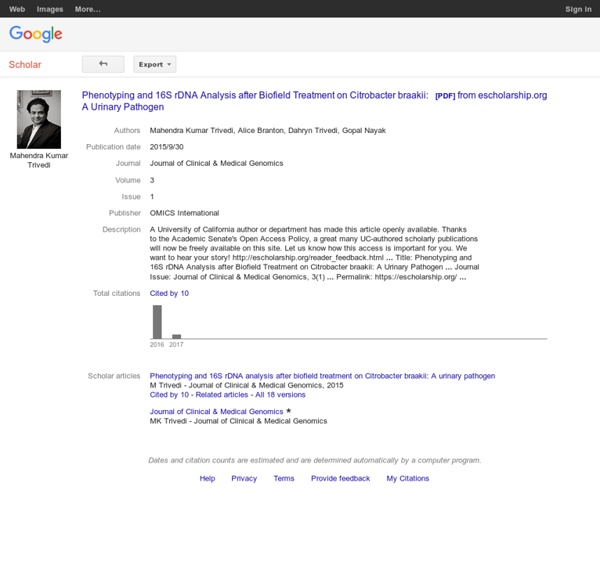



Phenotyping Analysis of Citrobacter Braakii after Biofield Treatment Description Citrobacter braakii (C. braakii) is widespread in nature, mainly found in human urinary tract. The current study was attempted to investigate the effect of Mr. Trivedi’s biofield treatment on C. braakii in lyophilized as well as revived state for antimicrobial susceptibility pattern, biochemical characteristics, and biotype number. Study of Biochemical Characteristics of Citrobacter Braakii Research Article Open Access Trivedi et al., J Clin Med Genom 2015, 3:1 Volume 3 • Issue 1 • 1000129 J Clin Med Genom ISSN: IJGM, an open access journal
Phenotyping and 16S rDNA Analysis after Biofield Treatment on Citrobacter braakii: A Urinary Pathogen Share this: Embed* Cite this: Phenotyping and 16S rDNA Analysis after Biofield Treatment on Citrobacter braakii: A Urinary Pathogen Citrobacter braakii (C. braakii) is widespread in nature, mainly found in human urinary tract. The current study was attempted to investigate the effect of Mr. Trivedi’s biofield treatment on C. braakii in lyophilized as well as revived state for antimicrobial susceptibility pattern, biochemical characteristics, and biotype number. 16s rDNA Sequencing of Human Energy Treated C. Braakii Title: Phenotyping and 16S rDNA Analysis after Biofield Treatment on Citrobacter braakii: A Urinary Pathogen Publication: Journal of Clinical & Medical Genomics Select license:
Citrobacter Braakii – Study of Biochemical Characteristics Abstract Citrobacter braakii (C. braakii) is widespread in nature, mainly found in human urinary tract. The current study was attempted to investigate the effect of Mr. Trivedi’s biofield treatment on C. braakii in lyophilized as well as revived state for antimicrobial susceptibility pattern, biochemical characteristics, and biotype number. Lyophilized vial of ATCC strain of C. braakii was divided into two parts, Group (Gr.) I: control and Gr.
The Science Behind The Trivedi Effect® Atoms exist in all states of matter. Even the cells of microbes, plants, human beings and all other living / non-living things consist entirely of atoms in the form of complex molecules. Atoms, at the most elementary level, are made from electrons, protons, neutrons and several known and unknown subatomic particles. Physicists and chemists hypothesize several theories to explain the systematic and disciplinary existence of various species inside the atom, the nature of bonds between atoms in condensed states (such as solids and liquids), as well as for the way the particles are working inside the atom. There have been several attempts to develop a unified picture that links the macroscopic universe and the microscopic atomic and subatomic world. The electromagnetic spectrum, of which visible light only forms a small portion of, arises from the cosmic radiation filtered by the atmosphere surrounding the planet.
The Potential Impact of Biofield Treatment on Human Brain Tumor Cells: A Time-Lapse Video Microscopy Abstract Study background: Glioblastoma (GBM) is the most common subtype of primary brain tumor in adults. The aim was to evaluate the impact of biofield treatment potential on human GBM and non-GBM brain cells using two time-lapse video microscopy technique. Antimicrobial Susceptibility Testing of Burkholderia Cepacia Abstract Burkholderia cepacia (B. cepacia) is an opportunistic, Gram negative pathogen which causes infection mainly in immunocompromised population and associated with high rate of morbidity and mortality in cystic fibrosis patients. Aim of the present study was to analyze the impact of biofield treatment on multidrug resistant B. cepacia. Clinical sample of B. cepacia was divided into two groups i.e. control and biofield treated. The analysis was done after 10 days of treatment and compared with control group. Control and treated group were analyzed for susceptibility pattern, MIC value, biochemical studies and biotype number using MicroScan Walk-Away® system.
Burkholderia Cepacia Antimicrobial Susceptibility Testing An Effect of Biofield Treatment on Multidrug-resistant Burkholderia cepacia: A Multihost Pathogen Mahendra Kumar Trivedi , Shrikant Patil , Harish Shettigar Mahendra Kumar Trivedi Mahendra Kumar Trivedi earned his 5-year Bachelor’s degree in Mechanical Engineering in 1985 . Mahendra Kumar Trivedi worked as an Engineer for 10 years. In 1995, Mr. Trivedi discovered that he had the unique ability to harness the energy from the universe and transmit it to anywhere on the globe, infusing it into living organisms and nonliving materials, thus optimizing their potential. For the next 5-7 years, Trivedi applied this newfound discovery to helping people optimize their potential, and this unique phenomenon resulting from Mr.